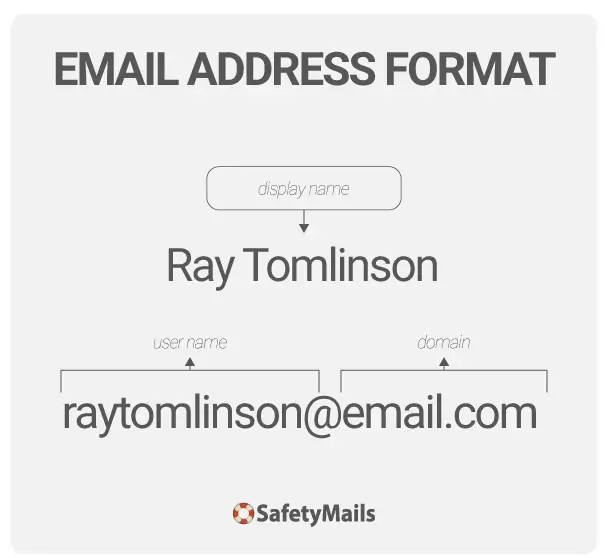Want to know why knowing the valid email address format is essential?
In a society where practically all activities depend on the Internet and its tools, personal and professional communication is based on direct messages, chats and, of course, emails.
As a result, validating email addresses has become essential for successful communication between people, whether in the private or corporate sphere, mainly as a record of information, agreements, negotiation histories, etc.
Table of Contents
What is a valid email address format?
A valid email address format follows a specific pattern of structural rules that includes a prefix, the “@” symbol and a domain.
This format has existed since the creation of email in the 1970s and continues today, more than 50 years later. We can say that it is the oldest online communication medium and one that has stood the test of time.
Various communication tools have been created and discontinued since the invention of the Internet, yet email has basically followed the same concept since the beginning and maintains its fundamental character as an indispensable tool for business.
Essential components of an valid email address format
An email address basically consists of 3 elements. Prefix (local-part), separator (@ symbol) and domain.

Prefix (local-part)
The prefix is the part that comes before the @ symbol. It can contain letters, numbers, dots, dashes and underscores.
The purpose of this part is to indicate to whom an email message should be delivered in a given domain.
Here are some examples of prefixes:
- Letters:
- john
- jane
- Numbers:
- john123
- jane2024
- Points:
- john.doe
- jane.doe
- Strokes:
- john-doe
- jane-doe
- Underscores:
- john_doe
- jane_doe
Combined Examples:
- Combining Letters and Numbers:
- john123.doe
- jane2024-doe
- Combining Letters and Dots:
- john.doe_01
- jane_doe.2024
- Combining letters, dots and dashes:
- john-doe.123
- jane.doe-2024
- Combining Letters, Strokes and Underscores:
- john_doe-123
- jane-doe_2024
Symbol @
The @ symbol is a divider that separates the prefix from the domain. Without it, the email address is not considered valid.
However, it would be anticlimactic to have a one-line reply, don’t you think? So let’s find out more about the “@” symbol:
The @ symbol, before the digital age, was used in commercial contexts, meaning “at the price of” or “at the rate of”. For example, “10 items @ $0.50 each” meant “10 items priced at 0.50 cents each”.
This symbol was chosen by the father of email, engineer Ray Tomlinson, during the development of the first networked email system (ARPANET) in 1971. He needed to choose a symbol that would separate the username from the hostname (domain), basically meaning “message to user AT (@) domain”. The criteria Tomlinson used was that it had to be a rare symbol that didn’t appear in usernames and wasn’t used elsewhere. In this case, @ fitted the bill perfectly.
From then on, the @ became the divider that separates the username (prefix) from the domain name, indicating that messages should be delivered to the domain indicated, for a specific user.
Domain
The domain is the part that comes after the @ symbol. It consists of a domain name and an extension (e.g. .com, .org, .br). Example: ” company.com”.
This part of the address complements the recipient with the place where the message will be delivered. This domain can be from an email service provider (free or paid) or a corporate email.
However, to be able to process email messages (both sending and receiving), having a registered domain is not enough. You need to take care of a series of measures:
- Have an email server capable of receiving, storing and allowing access to email messages. This server can be your own or from third-party services such as Google Workspace, Microsoft 365, Zoho Mail, among others.
- Taking care of DNS (Domain Name System) records, such as MX (Mail Exchange), CNAME, SPF, DKIM and DMARC.
- Setting up an email server to receive messages, store them and allow access (with IMAP or POP3 protocols).
- Authentication and security, such as SSL/TLS methods.
Examples of valid and invalid email formats
Summarizing the above, you can say that valid email address formats are those that follow the structural rules we presented for the prefix and the domain.
On the other hand, those that don’t follow these rules are no longer valid email address formats, for example:
- Lack of domain extension (such as .com, .org, etc.): every domain needs an extension (TLD – Top level domain).
- Example: username@company
- Missing prefix before the “@” symbol: the @ symbol is required to separate the domain prefix.
- Example: @domain.com
- Two consecutive dots in the prefix: invalid use of characters.
- Example: [email protected]
- Dot right after the “@” symbol: use of invalid characters.
- Example: [email protected]
- Use of a comma instead of a period to separate the domain: use of characters not allowed.
- Example: customer@company,com
- Two “@” symbols in the same address: use of invalid characters.
- Example: contact@[email protected]
Internationalized email addresses
An interesting fact: there are email addresses that use characters from alphabets other than the Latin alphabet, such as Cyrillic, Greek and others.
These addresses are known as internationalized email addresses (EAI – Email Address Internationalization).
Proponents of EAI say that these addresses promote linguistic inclusion, allowing speakers of other languages to use valid email address formats that are more natural and easier for them to remember.
Some examples of internationalized emails:
- Greek: χρήστης@παράδειγμα.ελ
- Cyrillic: пользователь@пример.рф
- Japanese: ユーザー@例え.日本
- Chinese: 用户@例子.中国
- Arabic: مستخدم@مثال.مصر
- Hebrew: משתמש@דוגמה.ישראל
Although the proposal is interesting and these are valid email address formats, not all email providers support EAI, limiting the scope and interoperability between email servers.
The importance of using a valid email address format
It may sound obvious, but it’s important to note that using valid email address formats is important to ensure that your messages are delivered correctly.
Ensuring that the email format is correct is the first step in guaranteeing the validity of an email address, i.e. that in addition to the appropriate format there is a user who is authorized and ready to receive the messages.
How do I make sure an email address is valid?
To ensure the quality and successful sending of your individual messages, as well as email marketing campaigns and automations, use verification tools that check the syntax, the existence of the domain and the presence of MX records.
Choosing SafetyMails as your email verification tool is an important measure to ensure that the emails you have in your contact lists are valid and existing. You can also use the real-time email verification API to ensure that the most common typing errors are avoided and only valid emails are registered.
Conclusion
Maintaining compliance with valid email address formats is fundamental to effective and professional communication. Ensuring the validity of emails not only improves the delivery rate of messages, but also strengthens trust and security in the exchange of electronic information.
FAQ
A valid email address format follows a specific standard that includes a prefix, the “@” symbol and a domain. The prefix can contain letters, numbers, dots, dashes and underscores. The “@” symbol separates the prefix from the domain, which is made up of a domain name and an extension, such as .com, .org, .br, among others. This format ensures that the email is recognized and processed correctly by the servers.
The essential components of an email address are the prefix, the “@” symbol and the domain. The prefix is the part that comes before the “@”, and can contain letters, numbers and some special characters such as dots and dashes. The “@” is the crucial divider that separates the prefix from the domain. The domain is the part that comes after the “@”, made up of a name and an extension, which can be from an email service provider or a corporate domain.
The “@” symbol was chosen by Ray Tomlinson, the engineer who developed the first network email system in 1971. He needed a rare symbol that wouldn’t be used in user names and that would clearly separate the user name from the machine name (domain). The “@” was already used in commercial contexts to mean “at the price of” or “at the rate of”, which made it a suitable choice to indicate “message to user EM (@) domain”.
Internationalized email addresses (EAI) are those that use characters from alphabets other than the Latin alphabet, such as Greek, Cyrillic, Japanese, Chinese, Arabic and Hebrew. These addresses allow for greater linguistic inclusion, allowing speakers of different languages to use email addresses that are more natural and easier to remember. However, not all email providers support EAI, which can limit interoperability.
To ensure that an email address is valid, it is important to use verification tools that check the syntax, the existence of the domain and the presence of MX records. SafetyMails, for example, offers email verification tools that help ensure that the email addresses in your contact lists are valid and existing. In addition, SafetyMails’ real-time email verification API can be used to avoid common typing errors and ensure that only valid emails are registered.


